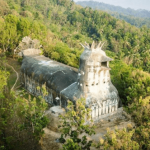 Music
Music  Music
Music  History
History 10 Less Than Jolly Events That Occurred on December 25
 Weird Stuff
Weird Stuff 10 Funny Ways That Researchers Overthink Christmas
 Politics
Politics 10 Political Scandals That Sent Crowds Into the Streets
 Weird Stuff
Weird Stuff Ten Bizarre Facts About The Doge Meme
 Our World
Our World 10 Ways Your Christmas Tree Is More Lit Than You Think
 Movies and TV
Movies and TV The 10 Coolest Stars to Set Sail on The Love Boat
 History
History 10 Things You Didn’t Know About the American National Anthem
 Technology
Technology Top 10 Everyday Tech Buzzwords That Hide a Darker Past
 Humans
Humans 10 Everyday Human Behaviors That Are Actually Survival Instincts
 Music
Music 10 Surprising Origin Stories of Your Favorite Holiday Songs
 History
History 10 Less Than Jolly Events That Occurred on December 25
 Weird Stuff
Weird Stuff 10 Funny Ways That Researchers Overthink Christmas
Who's Behind Listverse?

Jamie Frater
Head Editor
Jamie founded Listverse due to an insatiable desire to share fascinating, obscure, and bizarre facts. He has been a guest speaker on numerous national radio and television stations and is a five time published author.
More About Us Politics
Politics 10 Political Scandals That Sent Crowds Into the Streets
 Weird Stuff
Weird Stuff Ten Bizarre Facts About The Doge Meme
 Our World
Our World 10 Ways Your Christmas Tree Is More Lit Than You Think
 Movies and TV
Movies and TV The 10 Coolest Stars to Set Sail on The Love Boat
 History
History 10 Things You Didn’t Know About the American National Anthem
 Technology
Technology Top 10 Everyday Tech Buzzwords That Hide a Darker Past
 Humans
Humans 10 Everyday Human Behaviors That Are Actually Survival Instincts
10 Unusual Tombs from Around the World
When it comes to memorializing people in their final resting place, a widespread practice involves using a headstone as a marker where the person is buried. Usually, they have the name of the person, along with the date of their birth and death. Sometimes, there is an epitaph, an inscription that embodies the person who has passed on.
But what if you wanted to have something much more memorable. Some people forgo the traditional tombstone for a more elaborate crypt or tomb. And some of them can be quite impressive, with others a bit bizarre, shocking, and downright creepy. These are 10 unusual tombs from around the world.
Related: 10 Fabulous Graves (Almost) Worth Dying For
10 Inez Clarke Monument
The Inez Clarke Monument is a strange and haunting monument of unknown origin. The statue of a young girl holding a parasol sits on a pedestal at one of the graves in Chicago’s Graceland Cemetery. While that doesn’t seem to be too creepy, the fact that it’s encased in glass makes the statue a bit more haunting. The statue is believed to be haunted, and it has been reported that the little girl regularly comes to life and explores the cemetery during stormy weather.
Both security guards and bus tour drivers have claimed that they’ve noticed the statue missing at night before returning to its rightful place in the morning. There is, however, another mystery that surrounds the monument. Who is actually buried there? Although the plaque reads “Inez Clarke 1873–1880,” doubts about the real occupant still abound. Helen Sclair, an expert on Chicago cemeteries, a Chicago cemetery authority, once claimed that a little boy named Amos Briggs was actually buried there.[1]
9 Russia’s City of the Dead
Russia’s City of the Dead is hidden in one of the five mountain ridges dividing the Caucasus mountains. In this place, there is a cluster of peaked roofs and single-window brick houses surrounded by picturesque farmland and cascading clifftops. The City of the Dead, officially known as the village of Dargavs, is home to the graves of 10,000 bodies. There are several theories behind how the city came to be. One of the theories claims that during a plague, residents who were infected quarantined themselves in the single window brick houses and awaited death.
Another theory for how the city came to be is that during the 13th-century Mongol-Tatar invasion, locals living in the mountain valley of the Caucasus began to build these house-like above-ground crypts to conserve space. Yet a third theory suggests that the City of the Dead was created by migrating Sarmatians who settled in Southern Russia and buried their dead above ground in line with Indo-Iranian tradition. Whichever theory is correct, the City of the Dead is home to some unusual tombs.[2]
8 The Russian Countess Who Wanted Company in Her Tomb
Elisabeth Demidoff is a descendent of a Russian industrialist family who made their money in salt and fur. She married the Russian Count, Nikolai Nikitich Demidoff, who was also heir to an industrialist fortune. Unfortunately, the marriage broke down, and the pair separated.
After that, Elisabeth went to live in Paris, dying in 1818 at the age of 40. While her life may not have been of note, her final request was a bit on the creepy side. The story goes that after she died, her relatives were shocked to discover that her will included a provision leaving millions of francs to the person who would spend a year and a day in her tomb, sitting beside her coffin in the Père Lachaise cemetery in Paris. Many people have attempted the feat in a daring attempt to get rich quick, but no one has ever completed it, even though requests continued into the 1900s.[3]
7 The Tomb of Florence Irene Ford
Florence Irene Ford died of yellow fever in 1871 when she was just 10 years old. Throughout her young life, she feared storms, and she would rush to her mother to find comfort whenever there was a storm. After she died, the mother asked that her tomb be fitted with a small glass panel at her daughter’s head. A little creepy but not completely odd.
However, then the mother requested that access to the buried coffin be made by way of a narrow stairway leading down nearly 2 meters( 6 feet). Her mother also had a metal trapdoor installed at the top of the stairs so that she could shut it during a storm, protecting her from the wind and rain as she sat by her daughter, reading or singing to her until the storm passed.
The grave of Florence Irene Ford is located in Natchez City Cemetery at 19-27 Cemetery Road in Natchez, Adams County, Mississipi. The Cemetery is also home to a handful of other notable tombs.[4]
6 The Tomb of Mary Ellis
As the story goes, Mary Ellis came to New Brunswick to stay with her younger sister, Margaret, in the 1790s. At this time, she met and fell in love with a man who was a sea captain, rumored to have also been a Revolutionary War officer. The couple courted and made plans for the future. One day, duty called, and the captain sailed away over the Raritan River. Before leaving, he gave Mary his trusty horse and promised to return. So Mary waited, but the captain never returned.
Mary Ellis rode the horse to the river bank where the captain set sail every day, waiting to embrace her sweetheart when he came ashore, but he never did. By 1813, the captain hadn’t returned, but Mary didn’t give up. She bought farmland along the river and kept waiting. Finally, in 1828, she died, and her family buried her near the Raritan.
In the 1960s, there was a plan to build a store on Mary’s property, and the woods were cleared, leaving Mary’s headstone in the middle. There have been several different construction projects on the land over the years, but Mary’s headstone remains untouched. Today, the lone grave of Mary Ellis sits in a parking lot in New Jersey, making it one of the most unusual tombs in the world.[5]
5 The Tomb of Cyrus the Great
Pasargadae was one of the oldest residences of the Achaemenid kings, founded by Cyrus the Great, who reigned in Perisa from 559–530 BC. It resembled a park approximately 2 kilometers x 3 kilometers (1.25 miles x 1.85 miles) in which several monumental buildings were erected. According to the Roman geographer Strabo of Amasia, the palace of Pasargadae was built on the site where King Cyrus defeated the leader of the Medes, Astyages, in 550 BC.
The tomb of Cyrus the Great was built in the summer of 530 BC. The monument measure about 13 meters (42.5 feet) and about 11 meters (36 feet) high. There is a lower part and an upper part to the massive structure. The upper part consists of two chambers; one is the real tomb, a square room, and the other is an attic. There is also a rayed disk, some 50 centimeters (20 inches) in diameter, on the gable above the door; however, the significance of this disk is unknown. When Cyrus the Great was buried, the tomb chamber contained a gold sarcophagus, Cyrus’s weaponry, his jewelry, and his cloak. Although several centuries have passed since the tomb was originally built, and the monument is now a shadow of its former self, the tomb, however, still deserves to be remembered for its unusual design.[6]
4 The Okunoin Cemetery
The Shingon sect of Buddhism that resides on Mt. Koya holds a particular view of those who have passed. While they have a cemetery—Okunoin Cemetery—for the cremated, they do not think of it as a home to the dead but rather an area for waiting spirits. Buddhism doesn’t consider the body and spirit separate but as one entity intertwined to form a complex individual. The bridge to Okunoin actually serves as a boundary between worlds, and the cedar trees lining the path seem to open a barrier that welcomes you into the spirit world. A nighttime tour of the cemetery is especially creepy.
The Okunoin Cemetery is located in a 1200-year-old forest that houses the largest cemetery in Japan. It houses 200,000 graves, with many varying from the traditional Japanese grave—a headstone and a collection of wooden sticks engraved with names, containing a compartment to store the ashes of the deceased and a dedicated area for flowers, incense, and the family seal. Buddhist monks. The graves are gathered around the mausoleum of the founder of Shingon Buddhism, Lord Kukai (known posthumously as Kobo Daishi). And there seem to be some superstitions and strange objects lurking around as well, including the Miroku Stone, a large stone at the center of Okunoin that judges your sins. Lift it up and reveal your judgment—heavier for the sinful and light for the righteous.[7]
3 Love Struck Even in Death

The Père Lachaise is no ordinary cemetery. Built by Napoleon in 1804, it is Paris’s largest cemetery, covering over 40 hectares )98 acres) of land. This cemetery is home to many iconic tombs and is the final resting place of many musicians, actors, writers, and performers.
One of them is the tomb of Fernand Arbelot, who died in Paris, France, in the year 1942. Arbelot is remembered for his dying wish, which is that a monument be built on his grave, showing him gazing upon his wife. The tomb depicts a man lying on his back, holding up a disembodied head and gazing into its cold, stone eyes. An epitaph reads, “They were amazed at the beautiful journey which led them to the end of life.” One story goes that Arbelot helped speed up the need for the monument by killing his wife and then committing suicide. His grave monument was designed by Belgian sculptor Adolphe Wansart in 1946.[8]
2 The Nubian Pyramids of Sudan
Along the banks of the Nile River is a collection of hundreds of ancient pyramids in a desert in eastern Sudan. These pyramids have been the tombs of kings and queens, rulers of the Kush Kingdom for nearly 1000 years. It is worthy to note that the Nubian Pyramids are a huge attraction for Sudan’s tourists.
The pyramids were built between 2700 and 2300 years ago with decorative elements from the cultures of Pharaonic Egypt, Greece, and Rome. The Nubian pyramids differ from the pyramids in Egypt in their style of construction. Built of sandstone and granite, the steeply-sloping pyramids contain chapels and burial chambers decorated with illustrations and inscriptions carved in hieroglyphs and Meroitic script celebrating the rulers’ lives in Meroe—a wealthy Nile city and the seat of power of Kush, an ancient kingdom and rival to Egypt.[9]
1 William Jeffreys Got Buried in a Rock

William Jeffreys was elected to the North Carolina Senate in 1844 when he was just 28 years old. His tenure was off to a good start when he came down with a fever about a year later. During his illness, he had hallucinations and also developed a phobia of being buried in the ground and eaten by worms. So he told anyone who cared to listen that he wanted to be buried in a rock.
At first, no one took him seriously because he was young, energetic, and expected to recover from the fever. But as the days went on, Jeffreys grew weaker, casting doubt on his survival, and his father agreed to his burial request. It took a stone mason over a year to chisel out the rock. He also created a marble slab with an inscription honoring Jeffreys. Unfortunately, the slab got broken during shipment. It would take another year for the tomb to be fully completed.[10]








